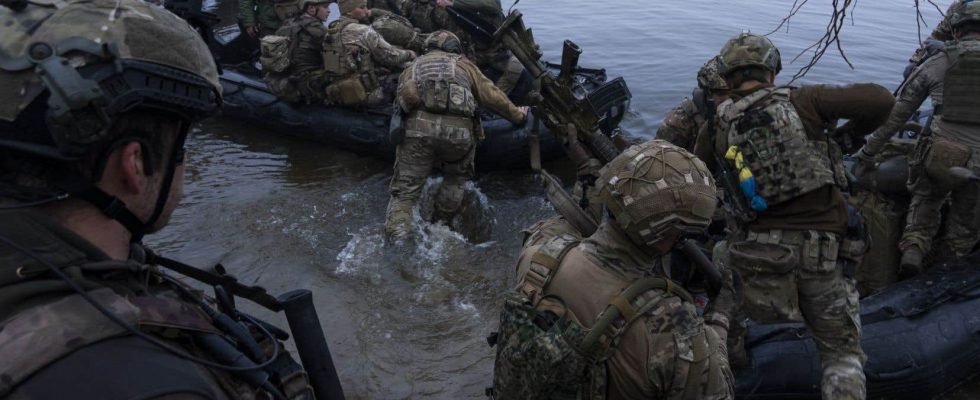Ukraine announced an advance of its troops on the left bank of the Dnieper occupied by the Russian army, a success after months of unsuccessful counter-offensive, but which will be difficult to convert into a real breakthrough, according to military experts interviewed by AFP.
Kiev claimed on Sunday to have pushed back the Russian army “from 3 to 8 km” deep on the left side of the Dnieper River, which had become a front line in southern Ukraine, without specifying whether its troops fully controlled this area of the Kherson region.
If this advance is confirmed, it would be the biggest push by the Ukrainian army against the Russians since the recapture of the village of Robotyné in the Zaporizhia region in August, while the counter-offensive was launched in June.
“Ukraine has a fairly extensive bridgehead on the left bank. The Russians are suffering losses there because the right bank, controlled by the Ukrainian armed forces, is located on a hill and it is much easier for them to fire on Russian troops from there,” according to the Russian commentator and journalist based in Vilnius Michael Nacke, sentenced in Russia in absentia to 11 years in prison for comments about the Russian army.
The leader of the occupied part of the Kherson region, Vladimir Saldo, admitted that “about one and a half companies” of Ukrainian soldiers, or several dozen or hundreds of men, had managed to anchor positions on the outskirts of the village of Krynky, while downplaying its importance.
According to pro-Kremlin military expert Alexander Khramchikhin, the land reconquered by the Ukrainians is “microscopic” and does not allow them to deploy military equipment. “Without equipment, no offensive, only losses,” he summarizes.
Moscow, however, replaced the commander of the Russian “Dnieper” military group operating in the area at the end of October, due to the difficulty of the situation according to analysts.
According to French military expert Michel Goya, the Ukrainian operation is “quite limited, quite symbolic”, but it “allows small victories to be declared after the failure of the main offensive”.
Heavy equipment required
To convert its success into a major breakthrough, the Ukrainian army must manage to deploy its army on the other side of the river, by crossing this large natural barrier then by maneuvering in a marshy area, in the middle of the rainy season in this southern area.
The Ukrainians’ first objective is to “cut off Russian supply routes.” To do this, they are constantly expanding their bridgehead, they are not only in Krynky, they are moving around,” according to Michael Nacke who emphasizes that Russia “does not have the most professional units in this region.”
The Ukrainian operation “maintains pressure on the Russians, who are forced to shift part of their reserves to the Dnieper, to the detriment of other sectors of the front”, also notes Michel Goya.
Taking positions in depth could also allow Kiev to launch a larger assault towards the Crimean peninsula, annexed by Russia in 2014. But to achieve this, experts estimate that thousands of men and vehicles would be needed. heavy.
For this, “bridges over the Dnieper are necessary, but any pontoon would be vulnerable to Russia’s air and land firepower which has not been completely suppressed”, and in particular to drones, estimates Mykola Bielieskov, analyst Ukrainian military.
Only bridges, existing or to be built, make it possible to transport heavy equipment and logistics. If we want to advance several tens of kilometers in depth, we must also advance our artillery otherwise we find ourselves cut off from all support,” explains Mr. Goya.
“The Ukrainians who crossed are infantrymen and naval commandos (in zodiacs, Editor’s note). They have a few vehicles, but overall remain very light. They are above all protected by their artillery remaining on the other side of the river,” notes the retired French colonel.
More generally, several military sources note, this area of Krynky is considered “secondary” by the Russians who concentrate their forces on Avdiïvka, an industrial city in the east that the Russian army is trying to encircle.
